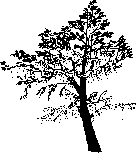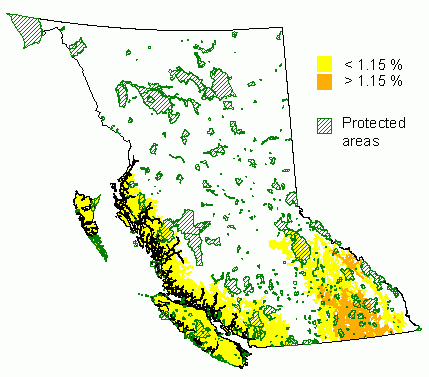 Pacific yew
Pacific yew
Taxus brevifolia Nutt.
Introduction
Pacific yew is a shrub or small tree. It grows scattered, singly or in isolated clumps, in the understory of conifers. It is a late seral species and has a high shade tolerance (Klinka et al. 2000). Pacific yew is most frequent on dry, warm sites with soils of medium moisture and nutrient regimes. Taxol, derived from the bark of Pacific yew, is used in cancer research and therapy. The effect of harvesting for taxol has been evaluated by Wolf and Wortman (1992). Biosynthesis of taxol now takes place in cell culture. Alternatively, more abundant precursors of the compound are isolated from foliage of various Taxus species. Thus, the demand for taxol no longer constitutes a threat for the species. The strong, durable wood was used widely by first peoples to make implements and other objects (Turner 1979).
The natural range of Pacific yew extends in a wide coastal belt from south Alaska to north California, as well as in an area on the western slopes of the Rockies, from south-eastern British Columbia into Idaho and Montana. Roughly half of its range is located in British Columbia (Little 1971; Burns and Honkala 1990).
Distribution and Protected Areas – from Hamann et.al. 2005



Conservation Status Summary – from Chourmouzis et.al. 2009
No in situ conservation concerns were identified for this species.
Reproduction
Pacific yew is a prolific seed producer, but the frequency of seed crops is unknown. Seed is dispersed mainly by birds, rodents and squirrels. Pacific yew is dioecious. Variation in sex expression has been investigated by DiFazio et al. (1996). The trees are capable of layering and often sprout from stumps after the top has been killed or the tree cut. In areas where slashburning is used, many of the yew trees have been burned. However, many of these stumps have subsequently resprouted, so the germplasm of yew has seemingly not been threatened (Burns and Honkala 1990).
Genetic structure
Results to date indicate that the shrubby versus tree habit of Pacific yew is environmentally induced (Wheeler et al. 1995). The seven currently recognized species of Taxus are very similar, they hybridize, and most of them contain taxol (Erdtman and Tsuno 1969), lending support to the view that there is but one species (Hartzell and Rust 1983). El-Kassaby and Yanchuk (1994) sampled 27 populations of Pacific yew from nine regions in British Columbia and analyzed allozyme variation at 21 loci. Only 8% of the variation was between regions, the remainder being within regions. Levels of genetic diversity were moderate: the average number of alleles per locus (A) was 1.7; the percentage of polymorphic loci (P) was 42.3%; and the expected number of heterozygotes (He) was 0.166. These levels are comparable to those of other species with the similar modes of reproduction (both sexual and asexual). Spatial genetic differentiation was moderate: the proportion of total diversity partitioned among regions (GST) was 0.077. Gene flow was estimated to be high (number of migrants per generation (Nm)=2.99), probably caused by seed distribution by animals. However, the methodology of deriving Nm from GST provides poor estimates. Nei’s genetic distances produced close agreement between genetic and geographic distances. Wright’s gene fixation index F was 0.472, which indicated high levels of inbreeding, likely caused by mating among relatives. The relative amount of asexual versus sexual propagation merits further study (El-Kassaby and Yanchuk 1994). Wheeler et al. (1995) sampled 32 populations from 11 regions and analyzed allozyme variation at 22 loci. Two regions were in the interior of British Columbia. The others were distributed in the U.S. part of the species’ range. Their results were similar to those of El-Kassaby and Yanchuk (1994), with 89% of variation occurring within populations, A=1.5, %P=41.6, He=0.124, GST=0.104 and Nm=2.15. Observed and expected heterozygosities differed little. However, they found little relationship between geographic and genetic distances. The Canadian populations were the most distinct. Stochastic events seem to have played a significant role in the postglacial establishment of Pacific yew (Wheeler et al. 1995). A genetic linkage map for T. brevifolia has been made based on RAPD markers (Gocmen et al. 1996).
Resource management and seed transfer
Somatic embryogenesis (Chee 1996) and vegetative propagation (Mitchell 1997) have been carried out with success and are available as tools for conservation.
REFERENCES
Hamann, A., Smets, P., Aitken, S. N. and Yanchuk, A. D. 2005. An ecogeographic framework for in situ conservation of forest trees in British Columbia. Can. J. For. Res. 35:2553-2561. View online resources for this report.
C. Chourmouzis, A.D. Yanchuk, A. Hamann, P. Smets, and S.N. Aitken. 2009. Forest Tree Genetic Conservation Status Report 1: In situ conservation status of all indigenous BC species. Centre for Forest Conservation Genetics, Forest Genetics Council of BC, and BC Ministry of Forests and Range, Forest Science Program, Victoria, BC Technical Report 053. www.for.gov.bc.ca/hfd/pubs/Docs/Tr/Tr053.htm
Burns, R. M. and Honkala, B. H. 1990. Silvics of North America vol.1: Conifers. Agriculture handbook 654. U.S. Dept. of Agriculture Forest Service, Washington, D.C. 675 p.
Chee, P. P. 1996. Plant regeneration from somatic embryos of Taxus brevifolia. Plant Cell Reports 16:184-187.
DiFazio, S. P., Vance, N. C. and Wilson, M. V. 1996. Variation in sex expression of Taxus brevifolia in western Oregon. Canadian Journal of Botany 74:1943-1946.
El-Kassaby, Y. A. and Yanchuk, A. D. 1994. Genetic diversity, differentiation, and inbreeding in Pacific yew from British Columbia. Journal of Heredity 85:112-117.
Erdtman, E. and Tsuno, K. 1969. Taxus heartwood constituents. Phytochemistry 8:931-932.
Gocmen, B., Jermstad, K. D., Neale, D. B. and Kaya, Z. 1996. Development of random amplified polymorphic DNA markers for genetic mapping in Pacific yew (Taxus brevifolia). Canadian Journal of Forest Research 26:497-503.
Hartzell, H. and Rust, J. 1983. Yew. Published by Hal Hartzell and Jerry Rust, Eugene, OR. 164 p.
Klinka, K., Worrall, J., Skoda, L. and Varga, P. 2000. The distribution and synopsis of ecological and silvical characteristics of tree species of British Columbia’s forests. Canadian Cartographics Ltd., Vancouver. 180 p.
Little, E., L., Jr. 1971. Atlas of United States trees, volume 1: Conifers and important hardwoods. U.S. Department of Agriculture. 9 p, 313 maps, Washington, DC.
Mitchell, A. K. 1997. Propagation and growth of Pacific yew (Taxus brevifolia Nutt.) cuttings. Northwest Science 71:56-63.
Turner, N. J. 1979. Plants in British Columbia Indian technology. B.C. Provincial Museum Handbook no. 38. BC Provincial Museum, Victoria, B.C. 304 p.
Wheeler, N. C., Jech, K. S., Masters, S. A., O’Brien, C. J., Timmons, D. W., Stonecypher, R. W. and Lupkes, A. 1995. Genetic variation and parameter estimates in Taxus brevifolia (Pacific yew). Canadian Journal of Forest Research 25:1913-1927.
Wolf, E. and Wortman, D. 1992. Pacific yew management on national forests: a biological and policy analysis. Northwest Environmental Journal 8:347-366.
